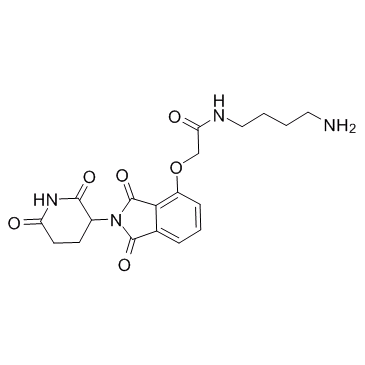E3 Ligase Ligand-Linker Conjugates 19
Modify Date: 2025-08-26 06:28:08

E3 Ligase Ligand-Linker Conjugates 19 structure
|
Common Name | E3 Ligase Ligand-Linker Conjugates 19 | ||
|---|---|---|---|---|
| CAS Number | 1799711-24-2 | Molecular Weight | 402.4 | |
| Density | N/A | Boiling Point | N/A | |
| Molecular Formula | C19H22N4O6 | Melting Point | N/A | |
| MSDS | N/A | Flash Point | N/A | |
Use of E3 Ligase Ligand-Linker Conjugates 19E3 Ligase Ligand-Linker Conjugates 19 is a degron-linker. The PROTAC linker is bound lo at least one targeting ligand. |
| Name | E3 Ligase Ligand-Linker Conjugates 19 |
|---|
| Description | E3 Ligase Ligand-Linker Conjugates 19 is a degron-linker. The PROTAC linker is bound lo at least one targeting ligand. |
|---|---|
| Related Catalog | |
| In Vitro | E3 Ligase Ligand-Linker Conjugates 19 is an amine intermediate (Compound 41), which can be used as is a heterobifunctional PROTAC BET degrader. The bromodomain and extra-terminal (BET) family proteins, consisting of BRD2, BRD3, BRD4, and testis-specific BRDT members, are epigenetic “readers” and play a key role in the regulation of gene transcription. BET proteins are considered to be attractive therapeutic targets for cancer and other human diseases. Recently, heterobifunctional small-molecule BET degraders have been designed based upon the proteolysis targeting chimera (PROTAC) concept to induce BET protein degradation[1]. E3 Ligase Ligand-Linker Conjugates 19 is a degron-linker (refer to Compound DL6-TL). Degron-linker-targeting ligand, wherein the linker is covalently bound lo at least one degron and at least one targeting ligand, the degron is a compound capable of binding to an ubiquitin ligase such as an E3 ubiquitin ligase (e g, cereblon), and the targeting ligand is capable of binding to the targeted protein (s)[2]. |
| References |
| Molecular Formula | C19H22N4O6 |
|---|---|
| Molecular Weight | 402.4 |
| Hazard Codes | Xi |
|---|